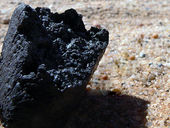
The car-sized asteroid, dubbed 2008 TC3, landed in northern Sudan on October 7, 2008, scientists report in the March 25 Nature. The study combines for one asteroid data that are usually separate: Comparing data from observations of the asteroid in while it was space with analysis of its meteorite fragments on Earth will yield new insights into asteroids, the scientists say.
Small asteroids like 2008 TC3 are fairly common, with about one asteroid impacting Earth each year. But these small asteroids are usually not spotted until they enter the Earth's atmosphere. "It's like when bugs splatter on the windshield. You don't see the bug until it's too late," says physicist and study coauthor Mark Boslough of Sandia National Laboratories in Albuquerque, N.M. Bigger asteroids are easier to spot but are much less common. "You'd see a baseball coming towards the windshield much sooner," Boslough says. And it's hard to detect the small asteroids because even powerful telescopes can only scan a small portion of the sky each night.
Scientists got lucky when they spotted 2008 TC3 using the Catalina Sky Survey telescope atop Mount Lemmon north of Tucson, Ariz. "It just so happened that the asteroid was coming from the direction that the telescope was pointed in," says astronomer and study coauthor Peter Jenniskens of the SETI Institute in Mountain View, Calif.
As 2008 TC3 hurtled through space, researchers studied the spectra of sunlight reflected from its surface to get information about the asteroid's mineral composition. The spectra showed that the asteroid was likely to come from the mysterious F-class of asteroids, a class only observed in space but not yet found as a meteorite on Earth..
Monitoring 2008 TC3's progress, researchers correctly predicted that it would impact the Nubian Desert of northern Sudan about 19 hours after it was first spotted. Eyewitnesses reported seeing a fireball as the asteroid exploded over the desert.
Jenniskens and 45 students and staff from the University of Khartoum in Sudan searched for remnants along the asteroid's projected path. The recovery team eventually found about 47 meteorites from 2008 TC3.
When the researchers got the meteorites back to the lab, they were in for a surprise. "The recovered meteorites were unlike anything in our collections up to that point," Jenniskens says.
Studying the ratio of oxygen isotopes revealed that the meteorites were of the rare ureilite category. "This is the first time that ureilites were linked to F-class asteroids," comments astronomer David Nesvorny of the Southwest Research Institute in Boulder, Colo. Researchers had previously thought ureilite meteorites came only from S-class asteroids.
Following 2008 TC3 also gave the researchers the opportunity to test their asteroid tracking devices. If a dangerously large asteroid was on a collision course with Earth, scientists would want to know that everything worked, Boslough says.



The object both exploded high in the atmosphere with kiloton-range force AND chunky fragments were scattered in the desert below. How do they know? because meteorite fragments, stamped all over with "2008 TC3", were collected like so much spilled candy from the Sudanese wilderness. The experts have explained everything - if I am confused, then I guess I am just stupid. [Link]